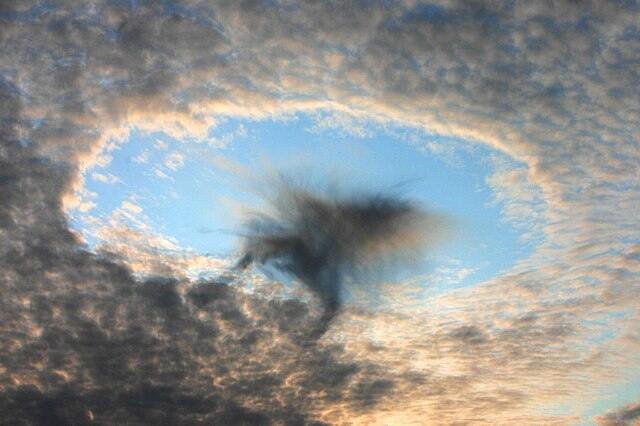The Fascinating Virga Hole: A Unique Weather Mystery
Have you ever looked up at the sky and noticed what appears to be a gap in the clouds, surrounded by a ring of precipitation? This captivating weather event is known as a Virga Hole or we can call it as Fallstreak hole (also known as a cavum, hole punch cloud, punch hole cloud, skypunch, cloud canal or cloud hole). In this article, we will explore the fascinating phenomenon of Virga Hole, shedding light on its chracteristics, formation, and significance.
Understanding Virga
Before we explore the Virga Hole in more detail, let’s understand virga itself. Virga is precipitation (rain) that falls from a cloud but evaporates before reaching the ground. This happens when the lower levels of the atmosphere are dry, causing the rain or snow to sublimate or evaporate before it reaches the Earth’s surface.
The Enigma of Virga Hole
Scientists characterize the Virga Hole as a unique variation of virga. It’s characterized by a circular or oval-shaped area within a cloud deck where precipitation is conspicuously absent. This creates a visually striking effect, resembling a “hole” in the cloud cover.

Fallstreak hole over Ann Arbor, Michigan – USA. Jtrombone, CC BY-SA 4.0, via Wikimedia Commons
Formation of a Virga Hole
Scientists primarily attribute the formation of a Virga Hole to variations in atmospheric conditions. When a cloud deck contains both saturated and unsaturated air layers, precipitation may fall from the cloud but evaporate before it reaches the ground. As the rain falls, a clear spot appears, creating a hole-like shape in the clouds.
Effects of Virga
Even though virga doesn’t bring rain or snow to the ground, it can still have important effects:
- Cloud Seeding: If virga is made of ice crystals from a cirrus cloud, it can spread to other lower clouds in the troposphere. This is more likely to happen in areas where the air is forced upward, like near mountains.
- Downward Currents: In dry regions like the Great Plains of America, heavy rain virga under a storm cloud (cumulonimbus) can create a powerful downward current. This leads to a strong gust of wind at the surface, and sometimes a sudden warm breeze.
- Turbulent Conditions: The difference in movement between areas with virga and those without precipitation can cause turbulence below the cloud. This turbulence can be risky for aircraft, making it important for pilots to be cautious.
Remember, even though virga doesn’t reach the ground, it can still have significant impacts in the atmosphere.

Virga during a sunset, a rare atmospheric phenomenon, seen at sunset over Saratov, Southwest Russia. Виктор Алексеев, CC BY-SA 4.0, via Wikimedia Commons
Meteorological Significance
The presence of a Virga Hole offers valuable insights to meteorologists regarding atmospheric conditions. Virga shows that the air lower down is dry. This can affect the weather, how humid it is, and whether it might rain in that place.
Observing a Virga Hole
To witness a Virga Hole, one must be in the right place at the right time. Scientists most commonly observe virga in regions with cloud cover and atmospheric conditions conducive to its formation. Search for round or oval holes in the clouds, and you might be lucky to see this fascinating weather event.
Conclusion
The Virga Hole is a remarkable meteorological event that makes our atmosphere more beautiful and complex. Its circular or oval void within a cloud deck offers a captivating visual display and provides valuable insights into atmospheric conditions. Keep an eye on the skies, and you may be fortunate enough to observe this intriguing meteorological event.
Different kinds of meteorites: chondrites, siderites, pallasites…
Photo credit (main picture): H. Raab (User:Vesta), CC BY-SA 3.0, via Wikimedia Commons
Photo description: A Hole Punch Cloud (or Fallstreak Hole), observed on August 17, 2008 about 20km (12.4 miles) south of Linz, Austria.
Sumber bacaan: PinterPandai, NASA Earth Observatory (.gov), WhatThisCloud, International Cloud Atlas



